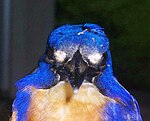Azure kingfisher
| Azure kingfisher | |
|---|---|

| |
| A. a. ruficollaris | |
| Scientific classification | |
| Domain: | Eukaryota |
| Kingdom: | Animalia |
| Phylum: | Chordata |
| Class: | Aves |
| Order: | Coraciiformes |
| Family: | Alcedinidae |
| Subfamily: | Alcedininae
|
| Genus: | Ceyx |
| Species: | C. azureus
|
| Binomial name | |
| Ceyx azureus (Latham, 1801)
| |
| Subspecies | |
| |
| Synonyms | |
|
Alcedo azurea | |
The azure kingfisher (Ceyx azureus) is a small
Description
The azure kingfisher measures 17–19 cm (6.7–7.5 in) in length,[2] and the male weighs 29–32 g (1.0–1.1 oz) while the female is slightly heavier at 31–35 g (1.1–1.2 oz).[3] It is a very colourful bird, with deep blue to azure back, a large white to buff spot on the side of the neck and throat, rufous-buff with some blue-violet streaks on the breast and flanks.[4] The feet are red with only two forward toes.[4] The lores (the region between the eye and the bill) are white and inconspicuous except in front view, where they stand out as two large white eye-like spots which may have a role in warding off potential predators.

Taxonomy
The
The generic name Ceyx (
Distribution and habitat
The azure kingfisher is found in northern and eastern Australia and Tasmania, as well as the lowlands of New Guinea and neighbouring islands, and out to North Maluku and Romang. The contact zone between the mainland Australian subspecies is along the east coast of
The habitat of the azure kingfisher includes the banks of vegetated creeks, lakes, swamps, tidal estuaries, and mangroves.[2][4]
It is common in the north of its range, tending to uncommon in the south.[4] It is generally sedentary, although some seasonal migration may occur.[4]
Behaviour
Feeding
The azure kingfisher feeds on small fish,
Breeding
The breeding season of the azure kingfisher is from September to April in northern Australia and from August to February in southern Australia, sometimes with two broods.[3] The nest is in a chamber at the end of a 1 m (3 ft 3 in) long burrow in an earthen creek bank.[2] A clutch of 4–6 white, rounded, glossy eggs, measuring 22 mm × 19 mm (0.87 in × 0.75 in), is laid.[4] Both parents incubate the eggs for 20–22 days, and then feed the hatchlings for a further 3 to 5 weeks.[4][3] The nests are occasionally destroyed by floods and their contents may be taken by the brown snake.[3]
Voice
The azure kingfisher is usually silent, but makes a sharp, squeaky call when breeding.[4] Its voice is a high-pitched, shrill "pseet-pseet", often in flight.[3][2]
Conservation status
Although the population of azure kingfishers is decreasing, their wide distribution enables classification as a species of
References
- ^ . Retrieved 19 November 2021.
- ^ ISBN 073222436-5
- ^
- ^ ISBN 978174021417-9
- ^ (HTML abstract)
- ^ a b Jobling, James A. (2010). "Helm Dictionary of Scientific Bird-names". Retrieved 15 June 2020.
- Slater, Peter; Slater, Pat & Slater, Raoul (1989): ISBN 0-947116-99-0
External links
- Photos, audio and video of azure kingfisher from Cornell Lab of Ornithology's Macaulay Library
- Photo gallery & description
- Photos of azure kingfisher from Graeme Chapman's photo library

